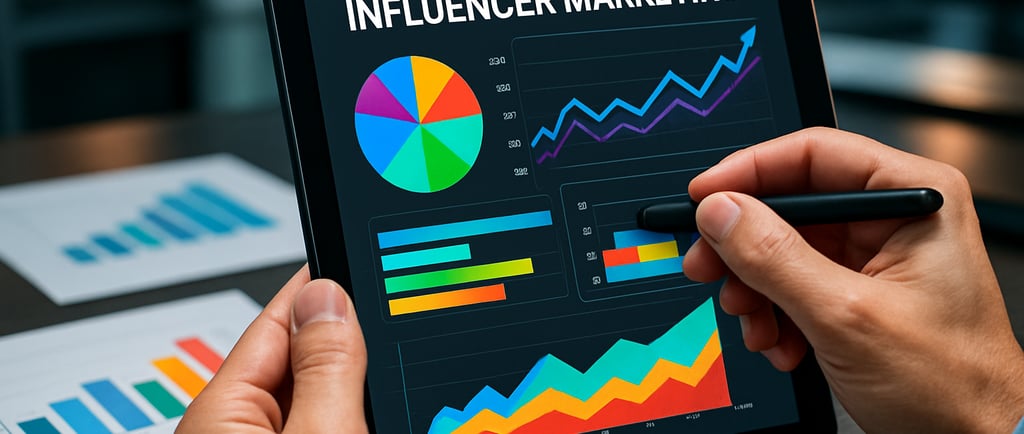How to Measure ROI in Influencer Marketing
measuring influencer marketing ROI | How to Measure ROI in Influencer Marketing | Decision |
7/22/20254 min read


1. Introduction: Understanding the Importance of Measuring ROI in Influencer Marketing
In today's digital age, influencer marketing has become a powerful tool for businesses looking to reach their target audience in a more authentic and engaging way. However, one of the biggest challenges companies face when implementing influencer marketing strategies is measuring the return on investment (ROI). Without a clear understanding of the impact influencers are having on their brand, businesses may struggle to justify their marketing spend and optimize their campaigns for better results. In this blog, we will explore the various methods and metrics used to measure ROI in influencer marketing, providing you with valuable insights to make informed decisions and maximize the effectiveness of your campaigns.
2. The Current Landscape of Influencer Marketing Metrics
2. The Current Landscape of Influencer Marketing Metrics
To effectively measure ROI in influencer marketing, it is crucial to understand the diverse metrics used in the industry. From engagement rates and reach to conversion rates and follower growth, there are various aspects to consider when evaluating the success of your influencer campaigns. Additionally, tracking metrics like website traffic, click-through rates, and sales attributed to influencer collaborations can provide a more comprehensive view of the impact on your bottom line. By staying informed about the evolving landscape of influencer marketing metrics, businesses can refine their strategies, allocate resources strategically, and achieve a higher return on investment. Stay tuned as we delve deeper into these key metrics and their significance in determining the success of your influencer marketing initiatives.
3. Key Components of ROI in Influencer Marketing
3. Key Components of ROI in Influencer Marketing
When calculating ROI in influencer marketing, it's essential to consider both the quantitative and qualitative aspects. Quantitative metrics such as sales revenue, conversion rates, and cost per acquisition provide concrete data on the financial impact of your influencer collaborations. On the other hand, qualitative measurements like brand sentiment, brand recall, and audience engagement offer insights into the intangible benefits that influencers can bring to your brand. By analyzing a combination of these key components, businesses can paint a holistic picture of their ROI and make informed decisions on future influencer partnerships. Understanding the intricate balance between quantitative and qualitative metrics is crucial to maximizing the success of your influencer marketing endeavors. Stay tuned for practical tips on how to effectively measure and optimize ROI in influencer marketing.
4. Methods for Accurately Measuring Influencer Marketing ROI
4. Methods for Accurately Measuring Influencer Marketing ROI
To accurately measure ROI in influencer marketing, businesses can employ various methods to track and analyze the performance of their collaborations. Utilizing unique tracking links or discount codes provided by influencers can help attribute sales directly to their efforts. Implementing advanced analytics tools to monitor website traffic, click-through rates, and engagement levels driven by influencers can provide valuable insights into campaign effectiveness. Surveys and focus groups can also be utilized to gather qualitative feedback on brand perception and audience sentiments post-collaboration. Leveraging these methods in combination with the key components of ROI discussed earlier can help businesses analyze the overall impact and effectiveness of their influencer marketing strategy. Stay tuned for actionable steps on optimizing ROI measurement in influencer marketing.
5. Common Challenges in Measuring ROI and Strategies to Address Them
5. Common Challenges in Measuring ROI and Strategies to Address Them
Despite advancements in tracking methods, businesses often face challenges when measuring ROI in influencer marketing. Common obstacles include difficulties in accurately attributing sales to specific influencers, tracking the impact of non-sales metrics like brand awareness, and aligning influencer goals with business objectives. To address these challenges, businesses can implement strategies such as creating unique landing pages for each influencer to track conversions, utilizing social listening tools to gauge sentiment and brand mentions, and establishing clear KPIs with influencers to ensure alignment with business goals. By overcoming these obstacles, businesses can gain a more comprehensive understanding of their influencer marketing ROI and make informed decisions to optimize future campaigns. Stay tuned for expert tips on effectively overcoming these challenges.
6. Tools and Technologies for Tracking Influencer Marketing Success
6. Tools and Technologies for Tracking Influencer Marketing Success
In the ever-evolving landscape of influencer marketing, leveraging the right tools and technologies is crucial for measuring ROI effectively. Utilize robust influencer marketing platforms like AspireIQ, Traackr, or CreatorIQ to streamline campaign management, track performance metrics, and analyze data insights. Additionally, consider integrating specialized tracking tools like Google Analytics, Bitly, or Hootsuite to monitor website traffic, link clicks, and social media engagement driven by influencers. These tools offer in-depth analytics, customizable reporting, and real-time data visualization to help you quantify the impact of influencer collaborations accurately. Stay ahead of the curve by leveraging these tools to optimize your influencer marketing strategies and maximize ROI.
7. Conclusion: Optimizing Your Influencer Marketing Strategy Through Effective ROI Measurement
As the influencer marketing landscape continues to evolve, effective ROI measurement becomes paramount for the success of your campaigns. By leveraging advanced tools and technologies for tracking performance metrics and data insights, you can not only quantify the impact of influencer collaborations but also optimize your strategies for maximum ROI. Remember, the key to success lies in continuous monitoring, analysis, and adjustment based on the data obtained. Stay proactive in exploring new tools, staying updated on industry trends, and refining your approach to influencer marketing. By prioritizing ROI measurement, you can propel your brand towards sustainable growth and success in the competitive influencer marketing space.
